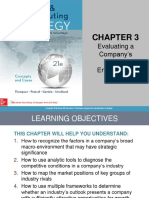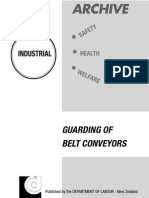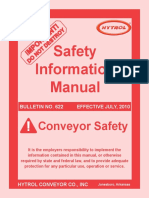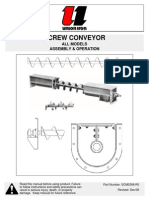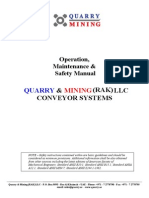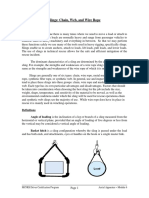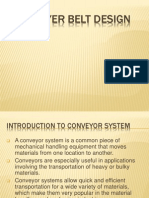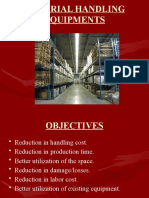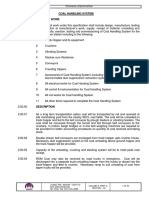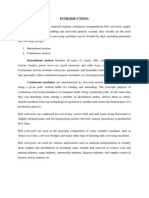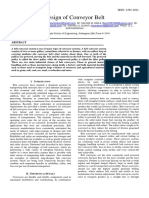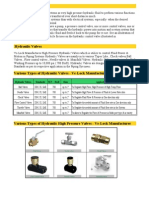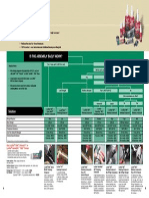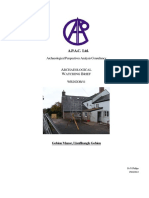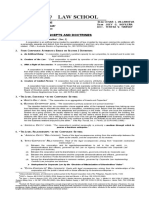100%(2)100% found this document useful (2 votes)
2K viewsOSHA Conveyor Standards
OSHA Conveyor Standards
Uploaded by
mrkadu_61This document summarizes OSHA standards for conveyor safety. It states that conveyor systems must have audible warning signals before starting, emergency stop switches, and guards to prevent contact with moving parts. It also requires signs marking conveyor areas, locks and tags for conveyors during maintenance, and compliance with ANSI safety standards for conveyor design and operation. Training employees on conveyor safety procedures and hazards is emphasized.
Copyright:
Attribution Non-Commercial (BY-NC)
Available Formats
Download as PPT, PDF, TXT or read online from Scribd
OSHA Conveyor Standards
OSHA Conveyor Standards
Uploaded by
mrkadu_61100%(2)100% found this document useful (2 votes)
2K views49 pagesThis document summarizes OSHA standards for conveyor safety. It states that conveyor systems must have audible warning signals before starting, emergency stop switches, and guards to prevent contact with moving parts. It also requires signs marking conveyor areas, locks and tags for conveyors during maintenance, and compliance with ANSI safety standards for conveyor design and operation. Training employees on conveyor safety procedures and hazards is emphasized.
Copyright
© Attribution Non-Commercial (BY-NC)
Available Formats
PPT, PDF, TXT or read online from Scribd
Share this document
Did you find this document useful?
Is this content inappropriate?
This document summarizes OSHA standards for conveyor safety. It states that conveyor systems must have audible warning signals before starting, emergency stop switches, and guards to prevent contact with moving parts. It also requires signs marking conveyor areas, locks and tags for conveyors during maintenance, and compliance with ANSI safety standards for conveyor design and operation. Training employees on conveyor safety procedures and hazards is emphasized.
Copyright:
Attribution Non-Commercial (BY-NC)
Available Formats
Download as PPT, PDF, TXT or read online from Scribd
Download as ppt, pdf, or txt
100%(2)100% found this document useful (2 votes)
2K views49 pagesOSHA Conveyor Standards
OSHA Conveyor Standards
Uploaded by
mrkadu_61This document summarizes OSHA standards for conveyor safety. It states that conveyor systems must have audible warning signals before starting, emergency stop switches, and guards to prevent contact with moving parts. It also requires signs marking conveyor areas, locks and tags for conveyors during maintenance, and compliance with ANSI safety standards for conveyor design and operation. Training employees on conveyor safety procedures and hazards is emphasized.
Copyright:
Attribution Non-Commercial (BY-NC)
Available Formats
Download as PPT, PDF, TXT or read online from Scribd
Download as ppt, pdf, or txt
You are on page 1of 49
OSHA Conveyor Standards
OSHA Conveyor Standards
1926.555(a) General requirements. 1926.555(a)(1) Means for stopping the motor or engine shall be provided at the operator's station. Conveyor systems shall be equipped with an audible warning signal to be sounded immediately before starting up the conveyor.
OSHA Conveyor Standards
1926.555(a)(1) Means for stopping the motor or engine shall be provided at the operator's station. Conveyor systems shall be equipped with an audible warning signal to be sounded immediately before starting up the conveyor.
OSHA Conveyor Standards
1926.555(a)(2) If the operator's station is at a remote point, similar provisions for stopping the motor or engine shall be provided at the motor or engine location. 1926.555(a)(3) Emergency stop switches shall be arranged so that the conveyor cannot be started again until the actuating stop switch has been reset to running or "on" position.
OSHA Conveyor Standards
1926.555(a)(4) Screw conveyors shall be guarded to prevent employee contact with turning flights. 1926.555(a)(5) Where a conveyor passes over work areas, aisles, or thoroughfares, suitable guards shall be provided to protect employees required to work below the conveyors.
OSHA Conveyor Standards
..1926.555(a)(6) 1926.555(a)(6) All crossovers, aisles, and passageways shall be conspicuously marked by suitable signs, as required by Subpart G of this part. 1926.555(a)(7) Conveyors shall be locked out or otherwise rendered inoperable, and tagged out with a "Do Not Operate" tag during repairs and when operation is hazardous to employees performing maintenance work.
OSHA Conveyor Standards
1926.555(a)(8) All conveyors in use shall meet the applicable requirements for design, construction, inspection, testing, maintenance, and operation, as prescribed in the ANSI B20.1-1957, Safety Code for B20.1Conveyors, Cableways, and Related Equipment.
Conveyor Safety Information & Resources
Is Your Conveyor Operation as Safe as it Should Be?
Conveyors are one of the best productivityproductivityenhancing tools available to warehouses, industrial facilities, and distribution centers, but conveyor injuries in the U.S. cost employers millions of dollars every year. That s money you can save and pain you can avoid with the right processes and design. In fact, conveyors are generally safer than other material handling alternatives if they are maintained, designed and properly operated.
Is Your Conveyor Operation as Safe as it Should Be?
The U.S. Department of Labor Bureau of Labor Statistics reports over fifty workplace fatalities a year where conveyors are the primary source of injury. Workplace injuries account for nearly 25% of all workers compensation claims and up to 35% of all associated costs. Clearly, your company cannot afford to ignore conveyor safety, and must actively find ways to enforce it.
Unsafe Conditions & Environmental Causes
Inadequate guarding, or unguarded conveyors are a crucial safety breach that can be minimized with good training and employee awareness. We always recommend having adequate conveyor guarding in every situation. It can be expensive, too: Unguarded conveyor belts that exposed workers at a Worcester, Mass., CVS Pharmacy to possible fractures and crushing injuries resulted in $61,575 in fines from OSHA. Clearly, you want to avoid these kinds of fines and the potential injuries that can result by unsafe conditions.
Unsafe Conditions & Environmental Causes
Defective conveyor equipment is unproductive and dangerous. When conveyors are not running at correct speeds, belt tensions, or in other ways, accidents can result. Your people should be trained to avoid these situations, and to report any malfunctioning conveying equipment as soon as they re aware of it.
Unsafe Conditions & Environmental Causes
Conveyors that are arranged hazardously can be a source of accidents. If your conveyor layout is made so that it flows foot traffic into areas where people can come into contact with moving conveyors, training can help them avoid injuries. Many order pickers are in contact with conveying equipment on a frequent basis. Instructing them how to safely utilize the conveyors and how to avoid contact with them is an investment that will pay off.
Unsafe Conditions & Environmental Causes
Another possibility is that overhead or elevated conveyors may result in conveyed items that fall, possibly causing injuries. To avoid this, we recommend that conveyors be guarded either with railings, safety netting, or other fall protection products that prevent conveyed items from falling onto people who walk beneath.
Conveyor Safety Training is Fundamental
In the CVS case, OSHA inspectors also discovered that employees were not instructed on how to prevent accidental conveyor startups while clearing product jams and the company lacked written instructions for doing so. Employees also faced tripping hazards from material stored directly in front of the conveyor. These conditions resulted in three alleged serious violations with $6,375 in proposed fines.
Conveyor Safety Training is Fundamental
Any facility that utilizes conveyors should work to train everyone involved in safe operations. This should include frequent updates and refresher classes. Training and process are probably the single most important aspect of conveyor safety. Everyone involved in a conveyor-using facility conveyorcan be responsible for safety. Preventing unsafe acts should be part of your culture.
Conveyor Safety Training is Fundamental
Operating conveyors without training or authority should be avoided. People who don t understand how the system might react shouldn t be at the controls, even if the degree of complexity is simple on the surface. Always be sure to train everyone who works in a conveyor area about how to operate the equipment and where the controls are. Everyone should know where stop switches are, how to use them, and when to use them.
Conveyor Safety Training is Fundamental
Conveyors should never be operated in an unsafe manner. This includes people standing or riding on the conveyor, overloading it, or reaching into or under the conveyor when it s in motion. At times, people will deactivate safety devices to expedite work or to quicken the pace. You should understand what devices are installed on a conveyor to make it safer, and be sure yours are always operational and in place. Your employees should report any inoperative devices or other hazards as a matter of process, as quickly as possible. Employees should never knowingly use unsafe equipment.
Conveyor Safety Training is Fundamental
Unsafe loading of conveyors is another factor. When people understand where conveyors are to be loaded, and how to interact with the equipment, the chances of injuries are reduced significantly. Loading a conveyor over guards or railing, for instance, increases the chance the employee bending incorrectly or unsafely, or that he will load near a drive or motor and have a better chance of catching clothing in the rollers.
Conveyor Safety Training is Fundamental
Workstations that include lift tables or other ergonomic devices help to ensure employees load in the right position, as the devices make loading easier and faster, as well as safer. Obviously, many of the same principles apply when loading and lifting with conveyors as when lifting and loading elsewhere. Employees who are familiar with correct lifting techniques are less likely to be injured due to conveyors, especially when moderate to heavy items are being loaded and unloaded. Unsafe position and posture are critical to conveyor safety.
Conveyor Safety Training is Fundamental
In general, workers should never interact with in-motion conveyors. Conveyor lines incan be designed to move totes to a spur or workstation to be scanned, to be orderorderpicked, etc.
Get Employees Involved!
Establishing safety committees and inspection committees is one way to involve your people in issues involving their own safety. It helps both you and them to understand what issues may exist in the facility, and where people could be injured. Safety committees can frequently and comprehensively advise, evaluate, and investigate your material handling processes. The key for management is to get involved and ensure the committees meet, that they stay ononfocus, and that standards are set.
What are the Typical Conveyor Hazard Points?
According to FFVA Mutual Insurance Company, the top hazard points for conveyors are: Power transmissions Nip points Shear points Pinch points Spill points Areas under counterweights Transfer counterweights Transfer mechanisms Passage areas under conveyor Under special circumstances
How Do You Address these Specific Areas of Concern?
Guards - Guards constitute one of the more common types of safety devices used for the protection of conveyors. Guards are coverings or barricades provided for safety purposes, such as gears, chains, or nip point guards.
Area of Concern: Guards
Operation and Maintenance of Guards - It is the owner s responsibility to see that his conveyor/conveyor system is never operated unless the guarding provided is in place. Also, that all guards be maintained in a safe condition and warning signs be kept in legible condition.
Area of Concern: Power Transmission
Power Transmission - The need for power transmission equipment is common to all types of powered conveyors involving items such as drives, gears, shafts, couplings, etc. Conveyor equipment must be carefully examined by the owners to assure that guarding is provided for all exposed power transmission equipment to protect their operators and others in the work area from accidental contact. Typical items to be observed include:
Area of Concern: Drive Guards, Coupling Guards
Drive Guards for chain, v-belt, and gearing vmust be both practical and durable. Guards can be constructed of expanded metal, perforated or solid sheet metal, sire mesh, plastic, or other materials securely fastened to the conveyor framework. Coupling Guards must be provided around all direct connections between motors and gearboxes when couplings are used to connect shafts.
Area of Concern: Line Shaft Guards, End Shaft Guards
Line Shaft Guards Line shaft drives are still utilized on some types of conveyors to distribute power to the conveying mechanisms. Care should be taken in their location to prevent fingers, aprons, strings, or hair entering the line shaft guard. End Shaft Guards The protruding ends of rotating shafts or keyed shafts are particularly dangerous. Plastic end caps can be used to enclose ends to prevent items from becoming caught in shafts.
Area of Concern: Nip Points
Nip Points - Nip Point by definition is that point at which an element of the conveyor machinery moving in a line or rotating meets another element which is either rotating or moving in a line in such a manner that it is possible to nip, pinch, squeeze, or entrap objects coming in contact with one of the two elements.
Area of Concern: Guards Special Circumstances
Guarding Under Special Circumstances - All exposed, moving parts of a conveyor which present a hazard to employees at their workstation should be mechanically or electrically guarded or guarded by position or location. Ease of access or approach to conveying equipment is essential to assure proper and continuous usage. To assure an accessible and safe conveyor operation requires understanding between the design/manufacturer and safety training by the owner.
Area of Concern: Electrical Controls
Providing a safe working place involving conveyors also requires consideration of electrical controls. Companies that use powered conveyors should make reference to these sections of the Safety Standards regarding conveyor guarding using electrical controls and stop switches for safety.
More on Conveyor Safety
According to FFVA Mutual, the majority of conveyor accidents are a direct result of an original design or implementation error. Conveyor safety is generally considered as a part of general safety. The practices described in this article may not give sufficient attention to the nuances required to provide a safe conveyor system. The responsibility for the planning, design and implementation of a conveyor system is often fragmented, lacking central responsibility. Attention to these details at the very beginning of the conveyor purchasing process can result in enhanced safety in your facility.
Conveyor Safety Resources
Conveyor Safety Poster This printable poster can be posted in break rooms and conveyor area to reinforce training. Conveyor Safety Manual (PDF document): Click to read, right-click rightto download to your drive. Printable conveyor safety standards from Hytrol Conveyors, Inc. American Society of Safety Engineers Conveyor Safety Manual. Features case studies also illustrate that the nuances and special details required for the planning, design and implementation of a safe conveyor system are often overlooked in considering conveyor safety as part of a general safety program. Conveyor Safety Tips from The U.S. Department of Labor. Some tips on belt conveyor safety. Concepts and Techniques of Machine Guarding.
Keeping Conveyor Operators Safe with Emergency Stops
How we design conveyor systems to protect your employees and your business Visible signs, such as this one from Emedco are an excellent safety idea
Keeping Conveyor Operators Safe with Emergency Stops
Emergency stops and other safety designs cost more, but they make your people and your business safer. Conveyor systems that are accessible to operators must be equipped with emergency stops. (please note that we design our systems with these precautions - individual conveyors do not fall under the scope of this article). Guarded by location The only conveyors that don t require them are systems that are mounted more than eight feet above the working surface, since those are guarded by their elevation called guarded by location.
Keeping Conveyor Operators Safe with Emergency Stops
When any conveyor system isn't accessible to operators, it is guarded by location. The conveyor isn t accessible to warehouse workers, and can only be accessed by maintenance personnel who can lock out or tag out the conveyor before performing maintenance. All Emergency Stop circuits should fail in the event of a power loss to the Emergency Stop Circuit. In the event that an Emergency Stop is activated, the conveyor system must be inspected for unsafe or box jam conditions by the operators. Once it is verified that the condition has been resolved the system may be restarted. Safety by design
Keeping Conveyor Operators Safe with Emergency Stops
Our controls systems are design so that in order to restart the system, two things have to happen. First, the emergency stop pull cord or push button at the conveyor is reset, and then the start button at the panel is activated. Once the system is restarted the warning horn on the system must be sounded prior to conveyors starting again. All conveyor systems should be equipped with an audible warning horn. In order to provide a safe work environment for our customers and their employees any powered machinery provided will adheres to these minimum requirements for safety stops and operations. Safety Standards
Policies by Occupation Safety & Health Administration
The following are excerpts of Policies by Occupations Safety and Health Administration, American Society of Mechanical Engineers and the National Fire Protection Association regarding powered transmission and conveyor. OSHA 1926.555 (a)
Policies by Occupation Safety & Health Administration
(1) Means for stopping the motor or engine shall be provided at the operator s station. Conveyor systems shall be equipped with an audible warning signal to be sounded immediately before starting up the conveyor. (2) If the operator s station is at a remote point, similar provisions for stopping the motor or engine shall be provided at the motor or engine location. (3) Emergency stop switches shall be arranged so that the conveyor cannot be started again until the actuating stop switch has been reset to running or on position.
Policies by Occupation Safety & Health Administration
ASME B20.1-2003 Section 5.11.2 B20.1(a) Control stations should be so arranged and located that the operation of the equipment is visible from them, and shall be clearly marked or labeled to indicate the function controlled. (b) A conveyor that would cause injury when started shall not be started until personnel in the area are alerted by a signal or by a designated person that the conveyor is about to start. start.
Policies by Occupation Safety & Health Administration
(1) When a conveyor that would cause injury when started is automatically controlled or must be controlled from a remote location, an audible device shall be provided that can be clearly heard at all points along the conveyor where personnel may be present. The warning device shall be actuated by the controller device starting the conveyor and shall continue for a required period of time before the conveyor starts. A flashing light or similar visual warning may be used in conjunction with or in place of the audible device if more effective in particular circumstances.
Policies by Occupation Safety & Health Administration
(c) Remotely and automatically controlled conveyors, and conveyors where operator stations are not manned or are beyond voice and visual contact from drive areas, loading areas, transfer points, and other potentially hazardous locations on the conveyor path not guarded by location, position, or guards shall be furnished with emergency stop buttons, pull cords, limit switches, or similar emergency stop devices.
Policies by Occupation Safety & Health Administration
(1) All such emergency stop devices shall be easily identifiable in the immediate vicinity of such locations unless guarded by location, position, or guards. Where the design, function, and operation of such conveyor clearly is not hazardous to personnel, an emergency stop device is not required. (2) The emergency stop device shall act directly on the control of the conveyor concerned and shall not depend on the stopping of any other equipment. The emergency stop devices shall be installed so that they cannot be overridden from other locations.
Policies by Occupation Safety & Health Administration
(d) Inactive and unused actuators, controllers, and wiring should be removed from control stations and panel boards, together with obsolete diagrams, indicators, control labels, and other material that might serve to confuse the operator.
Policies by Occupation Safety & Health Administration
ASME B20.1-2003 B20.1Section 5.11.3 Safety Devices All safety devices, including wiring of electrical safety devices, shall be arranged to operate such that a power failure or failure of the device itself will no result in a hazardous condition. ASME B20.1-2003 B20.1-
Policies by Occupation Safety & Health Administration
Section 5.11.4 Conveyor controls shall be so arranged that, in case of emergency stop, manual reset or start at the location where the emergency stop was initiated shall be required for the conveyors and associated equipment to resume operation.
Policies by Occupation Safety & Health Administration
Before restarting a conveyor that has been stopped because of an emergency, an inspection of the conveyor shall be made and the cause of the stoppage determined. The starting device shall be locked or tagged out before any attempt is made to remove the cause of the stoppage, unless operation is necessary to determine the cause or to safely remove the stoppage. Refer to ANSI Z244.1-1982, American Z244.1National Standard for Personnel Protection Lockout/Tagout of energy Sources Minimum Safety Requirements. ASME B20.1-2003 Section 5.12 B20.1-
Policies by Occupation Safety & Health Administration
(b) Where safety is dependent upon stopping devices or starting devices or both, they shall be kept free of obstructions that could endanger personnel.
Policies by Occupation Safety & Health Administration
NFPA 79 Section 9.2.5.4.1.1 In addition to the requirements for stop, the emergency top shall have the following requirements: (1) It shall override all other functions and operations in all modes. (2) Power to the machine actuators, which causes a hazardous condition(s), shall be removed as quickly as possible without creating other hazards (e.g. by the provision of mechanical means of stopping requiring no external power, by reverse current braking for a Category 1 stop). (3) Reset of an emergency stop circuit shall not initiate a restart.
You might also like
- Asme B20.1 PDFDocument26 pagesAsme B20.1 PDFJohn Davies100% (1)
- Conveyor Belt Splicing GuideDocument13 pagesConveyor Belt Splicing Guidemrkadu_61100% (1)
- Screw Conveyor Design and DevelopementDocument42 pagesScrew Conveyor Design and DevelopementRohit Sengar100% (3)
- Conveyor Operation Maintenance ManualDocument148 pagesConveyor Operation Maintenance ManualRivan Paskalis100% (2)
- Conveyor Safety ChecklistDocument1 pageConveyor Safety Checklistdana setiawanNo ratings yet
- Conveyor SafetyDocument5 pagesConveyor Safetyrize1159No ratings yet
- Design, Fabrication and Testing of A Low Headroom Conveyor Transfer ChuteDocument132 pagesDesign, Fabrication and Testing of A Low Headroom Conveyor Transfer ChuteJakes100% (1)
- Conveyor Safety ChecklistDocument1 pageConveyor Safety Checklistdana setiawanNo ratings yet
- AA SPEC 371001 - Conveyor Pulleys and ShaftsDocument14 pagesAA SPEC 371001 - Conveyor Pulleys and Shaftsjonodo89No ratings yet
- On Your Guard: Machine SafetyDocument19 pagesOn Your Guard: Machine SafetyDusan Cincar100% (3)
- Belt Tension CalculationDocument6 pagesBelt Tension CalculationNurul HaqueNo ratings yet
- Overhead Crane Safety TrainingDocument71 pagesOverhead Crane Safety TrainingGovarthanan Gopalan100% (9)
- Hydraulic SymbolsDocument1 pageHydraulic SymbolsHemil ChauhanNo ratings yet
- Case AnalysisDocument5 pagesCase AnalysisLumen Pearl Magdaug53% (15)
- C3 Crafting & Executing Strategy 21eDocument62 pagesC3 Crafting & Executing Strategy 21eMuthia Khairani100% (1)
- NZ Guarding of Belt ConveyorsDocument28 pagesNZ Guarding of Belt Conveyors450gasgasNo ratings yet
- Best Practice Guideline Conveyor SafetyDocument17 pagesBest Practice Guideline Conveyor SafetyArturJaekel100% (1)
- Conveyor SafetyDocument4 pagesConveyor SafetynathansolaiNo ratings yet
- Conveyor Safety 1Document40 pagesConveyor Safety 1Mkhishwa67% (3)
- Conveyer SafetyDocument41 pagesConveyer SafetyGöksel Alpaslan100% (1)
- Conveyor SystemsDocument20 pagesConveyor SystemsRaia SeoNo ratings yet
- 255 Screw Conveyor ANSI R01Document30 pages255 Screw Conveyor ANSI R01Abhijit Ghosh100% (2)
- Conveyor BeltsDocument76 pagesConveyor Beltssusegaad100% (1)
- ConveyorDocument14 pagesConveyorchenkok_90No ratings yet
- Slings-Chains+wir RopesDocument30 pagesSlings-Chains+wir RopestonyNo ratings yet
- Conveyer Belt DesignDocument21 pagesConveyer Belt DesignAvinnash Vemula96% (25)
- Bulk Material Handling Product CatalogueDocument100 pagesBulk Material Handling Product CatalogueRaj K SharmaNo ratings yet
- Material Handling EquipmentDocument18 pagesMaterial Handling Equipmentvinit rockstarNo ratings yet
- CHP PDFDocument49 pagesCHP PDFdebu1985No ratings yet
- ConveyorDocument33 pagesConveyorRajashekar Reddy KandalaNo ratings yet
- Installing and Splicing Textile Conveyor Belts: EditionDocument34 pagesInstalling and Splicing Textile Conveyor Belts: EditionGarfang RattanapunNo ratings yet
- Dust Suppression Equations PDFDocument34 pagesDust Suppression Equations PDFkalaiNo ratings yet
- Belt Conveyor ManualDocument53 pagesBelt Conveyor ManualBUDAPES100% (1)
- Conveyor SDocument60 pagesConveyor SAshish Sharma100% (6)
- Idler DesignDocument6 pagesIdler DesignVaibhav GuptaNo ratings yet
- Cema 351Document6 pagesCema 351Andrea Fabiana Blaschi0% (1)
- Japan Pipe Belt Conveyor Sy...Document7 pagesJapan Pipe Belt Conveyor Sy...salkan_rahmanovic810No ratings yet
- COnveyor SkirtsDocument4 pagesCOnveyor SkirtsdivashmNo ratings yet
- Belt Conveyor Design Criteria Within Anglo American CorporationDocument20 pagesBelt Conveyor Design Criteria Within Anglo American Corporationwk13thNo ratings yet
- Wire Rope Slings Wire Rope SlingsDocument6 pagesWire Rope Slings Wire Rope SlingsegyinspectoryahooNo ratings yet
- Belt Conveyor RepDocument47 pagesBelt Conveyor Repganesh100% (1)
- AUMUND Bucket Elevator PDFDocument16 pagesAUMUND Bucket Elevator PDFMadhusudhan Gajula100% (5)
- Vibrating ConveyorsDocument28 pagesVibrating ConveyorsMusheer BashaNo ratings yet
- Design of Conveyor BeltDocument7 pagesDesign of Conveyor BeltNiraj Ghode100% (1)
- Troughed Belt ConveyorsDocument18 pagesTroughed Belt Conveyorsjyoti ranjan nayak80% (5)
- Conveyor Components Product Handbook PDFDocument52 pagesConveyor Components Product Handbook PDFJean GrégoireNo ratings yet
- Winch OperationsDocument9 pagesWinch Operationsdsn_sarmaNo ratings yet
- Conveyor BeltDocument30 pagesConveyor BeltJatin DarveNo ratings yet
- 00 - Pendahuluan Pesawat AngkatDocument43 pages00 - Pendahuluan Pesawat AngkatHasyim Maulana Abdul MalikNo ratings yet
- HSE Guidance Safe Use Magnetic Lifting DevicesDocument9 pagesHSE Guidance Safe Use Magnetic Lifting DevicesNixNo ratings yet
- Conveyor System & SafetyDocument54 pagesConveyor System & SafetyINDRAJIT SAO100% (1)
- Safety SwitchesDocument62 pagesSafety Switchesafonsobueno100% (1)
- CEMA GuidelinesDocument2 pagesCEMA GuidelinesasnandyNo ratings yet
- Scissor Lift Technical HandbookDocument35 pagesScissor Lift Technical HandbookAla Eddine Marzougui100% (2)
- Machine GuardingDocument78 pagesMachine GuardingJaime NovoaNo ratings yet
- Bucket Elevator Monitoring PDFDocument7 pagesBucket Elevator Monitoring PDFbulentbulutNo ratings yet
- Conveyors Safety SystemsDocument3 pagesConveyors Safety SystemsHatake KakasiNo ratings yet
- Conveyor Safety Advisory: "Working Safely Around Bulk Material Conveying Systems"Document4 pagesConveyor Safety Advisory: "Working Safely Around Bulk Material Conveying Systems"Andrada Roxana IonescuNo ratings yet
- Machine Guarding 1Document80 pagesMachine Guarding 1m_alodat6144No ratings yet
- File-1525797446Document2 pagesFile-1525797446Oscar SanchezNo ratings yet
- Conveyor Safety Basics - 12 Rules To LiveDocument4 pagesConveyor Safety Basics - 12 Rules To LiveHSE TATASURABAYANo ratings yet
- Improving Belt Conveyor Safety With Better Procedures and TrainingDocument6 pagesImproving Belt Conveyor Safety With Better Procedures and TrainingcdkueaNo ratings yet
- Aerial Lift Safety A Comprehensive GuideDocument8 pagesAerial Lift Safety A Comprehensive Guideabdnjd2024No ratings yet
- Hydraulic ClutchDocument12 pagesHydraulic Clutchmrkadu_610% (1)
- Dear Customer,: Ticket ConfirmationDocument1 pageDear Customer,: Ticket Confirmationmrkadu_61No ratings yet
- Piping StandardDocument425 pagesPiping StandardJitendra Bhosale100% (3)
- Principles of Electrical GroundingDocument43 pagesPrinciples of Electrical GroundingSaber HussainiNo ratings yet
- Ball ValvesDocument7 pagesBall ValvesRizal FalevyNo ratings yet
- NTN Bearing en AllDocument411 pagesNTN Bearing en Allbhupinder85No ratings yet
- Installation & Start Up of Axial Piston PumpDocument14 pagesInstallation & Start Up of Axial Piston Pumpmrkadu_61No ratings yet
- Retaining: Securing Cylindrical AssembliesDocument1 pageRetaining: Securing Cylindrical Assembliesmrkadu_61No ratings yet
- About Axial Displacement Pump A4VSoDocument68 pagesAbout Axial Displacement Pump A4VSomrkadu_61No ratings yet
- India Vs Australia Test Series ScheduleDocument3 pagesIndia Vs Australia Test Series Schedulemrkadu_61No ratings yet
- Axial Piston Pump CatalougeDocument36 pagesAxial Piston Pump Catalougemrkadu_61No ratings yet
- Spherical Roller Bearing SKF CatlougeDocument72 pagesSpherical Roller Bearing SKF Catlougemrkadu_61No ratings yet
- Delegated Legislation AssignmentDocument6 pagesDelegated Legislation AssignmentSwaira fariyadNo ratings yet
- 133: Gobion Manor, Monmouthshire, Watching Brief, APAC LTDDocument41 pages133: Gobion Manor, Monmouthshire, Watching Brief, APAC LTDAPAC LtdNo ratings yet
- LJ Zalia - TutorialDocument104 pagesLJ Zalia - TutorialFuji Rachfiani PutriNo ratings yet
- Company TypesDocument6 pagesCompany TypesTeodora IoanaNo ratings yet
- Sexual Harrasment LawDocument12 pagesSexual Harrasment LawLim Xu WinNo ratings yet
- APW3!12!1600 User GuideDocument8 pagesAPW3!12!1600 User GuidejuliogiorgiNo ratings yet
- ETABS-Example-Pushover 03Document53 pagesETABS-Example-Pushover 03ijumNo ratings yet
- 2022 Land Cruiser-Sahara Motors Dubai, Exporters of Brand-New Toyota Vehicles Across The GlobeDocument1 page2022 Land Cruiser-Sahara Motors Dubai, Exporters of Brand-New Toyota Vehicles Across The GlobekapwelllouisNo ratings yet
- Supporting Growth Through Innovation Network in UnileverDocument21 pagesSupporting Growth Through Innovation Network in Unileversuongxuongnui0% (1)
- Honeywell-Gent-Company ProfileDocument5 pagesHoneywell-Gent-Company ProfileZaid AhmedNo ratings yet
- Advantages of BusbarDocument7 pagesAdvantages of BusbarVíctor CasadoNo ratings yet
- NATELCO v. CA Case DigestDocument8 pagesNATELCO v. CA Case DigestMoireeGNo ratings yet
- Floor Plan ManagerDocument126 pagesFloor Plan Managersai pendyalaNo ratings yet
- SoP Guide by MITDocument6 pagesSoP Guide by MITNibasB.ApuNo ratings yet
- Quiz in Developing An ICT Project For Social ChangeDocument2 pagesQuiz in Developing An ICT Project For Social ChangePrincess Ira SantillanNo ratings yet
- Fundamentals of Advanced Accounting Hoyle 6th Edition Test Bank Download PDFDocument49 pagesFundamentals of Advanced Accounting Hoyle 6th Edition Test Bank Download PDFhirshdomowe100% (4)
- Report On Electronic Power SteeringDocument14 pagesReport On Electronic Power SteeringSatadru Bera60% (5)
- A Parameterized Complexity TutorialDocument19 pagesA Parameterized Complexity TutorialbobysiswantoNo ratings yet
- Practicing Shopping UtterancesDocument2 pagesPracticing Shopping UtterancesHernina Niblonk Kimguna100% (1)
- REBOL Essentials#37 09 Jan 2003Document68 pagesREBOL Essentials#37 09 Jan 2003Todd ThomasNo ratings yet
- ATRI Operational Costs of Trucking 2019 1Document48 pagesATRI Operational Costs of Trucking 2019 1minervascompanyNo ratings yet
- Date Ideas PDFDocument26 pagesDate Ideas PDFvickynew123No ratings yet
- International Marketing OrientationsDocument13 pagesInternational Marketing OrientationsScorpio GirlNo ratings yet
- Fernando TorresDocument33 pagesFernando TorresAliya SyafaNo ratings yet
- 2020 CORPORATE LAW OutlineDocument60 pages2020 CORPORATE LAW OutlineRalph Ronald Catipay60% (5)
- STP8 10 3AV 40 BE en 10Document98 pagesSTP8 10 3AV 40 BE en 10Tiên Lê Trần MỹNo ratings yet
- NACDAC_905561633_REVDocument2 pagesNACDAC_905561633_REVAnonymous sQgkEHRYNo ratings yet














